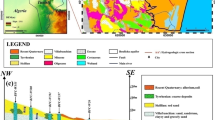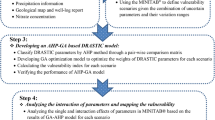Abstract
One of the major shortcomings with GALDIT model is the difficulty in specifying numerical constant values for the rating and weighting system of parameters of interest. The frequency ratio (FR) and genetic algorithm (GA) methods were applied in this research for the first time to improve the rates and weights of the GALDIT model. FR model was used to modify the rates of this model. Additionally, genetic algorithm was used to optimize the weights of GALDIT model based on the hydrological characteristics of the aquifer and the values of TDS parameter. The correlation between hybrid models of GALDIT-FR and GALDIT-GA were obtained as 0.69 and 0.61, respectively, while this correlation was increased up to 0.76 after combining the rates modified by FR statistical method and optimal weights of the genetic algorithm. The results of this model showed that the northwest and west parts of the study area have the highest vulnerability to seawater intrusion. So, it was concluded that a combination of meta-heuristic algorithm and statistical method provides more accurate result in the study region.






Similar content being viewed by others
Data Availability
All data generated or analyzed during this study are confidential.
References
Ayed, B., Jmal, I., Sahal, S., & Bouri, S. (2018). The seawater intrusion assessment in coastal aquifers using GALDIT method and groundwater quality index: The Djeffara of Medenine coastal aquifer (Southeastern Tunisia). Arabian Journal of Geosciences, 11(20), 609.
Motevalli, A., Moradi, H. R., & Javadi, S. (2018). A Comprehensive evaluation of groundwater vulnerability to saltwater up-coning and sea water intrusion in a coastal aquifer (case study: Ghaemshahr-juybar aquifer). Journal of Hydrology, 557, 753–773. https://doi.org/10.1016/j.jhydrol.2017.12.047.
Kazakis, N., Pavlou, A., Vargemezis, G., Voudouris, K. S., Soulios, G., Pliakas, F., & Tsokas, G. (2016). Seawater intrusion mapping using electrical resistivity tomography and hydrochemical data. An application in the coastal area of eastern Thermaikos Gulf. Greece. Science of the Total Environment, 543, 373–387.
Kazakis, N., Spiliotis, M., Voudouris, K., Pliakas, F. K., & Papadopoulos, B. (2018). A fuzzy multicriteria categorization of the GALDIT method to assess seawater intrusion vulnerability of coastal aquifers. Science of the Total Environment, 621, 524–534.
Neshat, A., & Pradhan, B. (2017). Evaluation of groundwater vulnerability to pollution using DRASTIC framework and GIS. Arabian Journal of Geosciences, 10(22), 501.
Neshat, A., & Pradhan, B. (2015). An integrated DRASTIC model using frequency ratio and two new hybrid methods for groundwater vulnerability assessment. Natural Hazards, 76(1), 543–563.
Saha, D., & Alam, F. (2014). Groundwater vulnerability assessment using DRASTIC and Pesticide DRASTIC models in intense agriculture area of the Gangetic plains. India. Environmental monitoring and assessment, 186(12), 8741–8763.
Neshat, A., Pradhan, B., Pirasteh, S., & Shafri, H. Z. M. (2014). Estimating groundwater vulnerability to pollution using a modified DRASTIC model in the Kerman agricultural area. Iran. Environmental Earth Science, 71(7), 3119–3131.
Neshat, A., Pradhan, B., & Shafri, H. Z. M. (2014). An integrated GIS based statistical model to compute groundwater vulnerability index for decision maker in agricultural area. Journal of the Indian Society of Remote Sensing, 42(4), 777–788.
Neshat, A., Pradhan, B., & Dadras, M. (2014). Groundwater vulnerability assessment using an improved DRASTIC method in GIS. Resources, Conservation and Recycling, 86, 74–86.
Nadiri, A. A., Gharekhani, M., & Khatibi, R. (2018). Mapping aquifer vulnerability indices using artificial intelligence-running multiple frameworks (AIMF) with supervised and unsupervised learning. Water Resources Management, 1–18.
Kaliraj, S., Chandrasekar, N., Peter, T. S., Selvakumar, S., & Magesh, N. S. (2015). Mapping of coastal aquifer vulnerable zone in the south west coast of Kanyakumari, South India, using GIS-based DRASTIC model. Environmental monitoring and assessment, 187(1), 4073.
Khosravi, K., Sartaj, M., Tsai, F. T. C., Singh, V. P., Kazakis, N., Melesse, A. M., et al. (2018). A comparison study of DRASTIC methods with various objective methods for groundwater vulnerability assessment. Science of the Total Environment, 642, 1032–1049.
Pacheco, F. A., & Sanches Fernandes, L. F. (2013). The multivariate statistical structure of DRASTIC model. Journal of Hydrology, 476, 442–459.
Kumar, P., Thakur, P. K., Bansod, B. K., & Debnath, S. K. (2017). Multi-criteria evaluation of hydro-geological and anthropogenic parameters for the groundwater vulnerability assessment. Environmental monitoring and assessment, 189(11), 564.
Barzegar, R., Moghaddam, A. A., & Baghban, H. (2016). A supervised committee machine artificial intelligent for improving DRASTIC method to assess groundwater contamination risk: A case study from Tabriz plain aquifer. Iran. Stochastic Environmental Research and Risk Assessment, 30(3), 883–899.
Pacheco, F. A., Martins, L. M. O., Quininha, M., Oliveira, A. S., & Fernandes, L. S. (2018). Modification to the DRASTIC framework to assess groundwater contaminant risk in rural mountainous catchments. Journal of Hydrology, 566, 175–191.
Sahoo, M., Sahoo, S., Dhar, A., & Pradhan, B. (2016). Effectiveness evaluation of objective and subjective weighting methods for aquifer vulnerability assessment in urban context. Journal of Hydrology, 541, 1303–1315.
Klassen, J., & Allen, D. M. (2017). Assessing the risk of saltwater intrusion in coastal aquifers. Journal of Hydrology, 551, 730–745.
Chachadi, A. G., & Lobo Ferreira, J. P. (2001). Seawater intrusion vulnerability mapping of aquifer using the GALDIT method. Coastin, 4, 7–9.
Mahrez, B., Klebingat, S., Houha, B., & Houria, B. (2018). GIS-based GALDIT method for vulnerability assessment to seawater intrusion of the Quaternary coastal Collo aquifer (NE-Algeria). Arabian Journal of Geosciences, 11(4), 71. https://doi.org/10.1007/s12517-018-3400-2.
Recinos, N., Kallioras, A., Pliakas, F., & Schuth, C. (2015). Application of GALDIT index to assess the intrinsic vulnerability to seawater intrusion of coastal granular aquifers. Environmental Earth Science, 73(3), 1017–1032.
Bouderbala, A., Remini, B., Hamoudi, S., & Pulido-Bosch, A. (2016). Assessment of groundwater vulnerability and quality in coastal aquifers: a case study (Tipaza, North Algeria). Arabian Journal of Geosciences, 9, 181.
Gorgij, A. D., & Moghaddam, A. A. (2016). Vulnerability Assessment of saltwater intrusion using simplified GAPDIT method: a case study of Azarshahr Plain Aquifer, East Azerbaijan. Iran. Arabian Journal of Geosciences, 9(2), 106. https://doi.org/10.1007/s12517-015-2200-1.
Gontara, M., Allouche, N., Jmal, I., & Bouri, S. (2016). Sensitivity analysis for the GALDIT method based on the assessment of vulnerability to pollution in the northern Sfax coastal aquifer. Tunisia. Arabian Journal of Geosciences, 9(5), 416.
Trabelsi, N., Triki, I., Hentati, I., & Zairi, M. (2016). Aquifer vulnerability and seawater intrusion risk using GALDIT, GQISWI and GIS: Case of a coastal aquifer in Tunisia. Environmental Earth Science, 75, 669. https://doi.org/10.1007/s12665-016-5459-y.
Saidi, S., Bouri, S., & Dhia, H. B. (2013). Groundwater management based on GIS techniques, chemical indicators and vulnerability to seawater intrusion modelling: application to the Mahdia-Ksour Essaf aquifer Tunisia. Environmental Earth Science, 70(4), 1551–1568. https://doi.org/10.1007/s12665-013-2241-2.
Chachadi, A. G. (2005). Seawater intrusion mapping using modified GALDIT indicator model-case study in Goa. Jalvigyan Sameeksha, 20, 29–45.
Bordbar, M., Neshat, A., & Javadi, S. (2019). Modification of the GALDIT framework using statistical and entropy models to assess coastal aquifer vulnerability. Hydrological Sciences Journal, 9, 1117–1128.
Bordbar, M., Neshat, A., Javadi, S., Pradhan, B., & Aghamohammadi, H. (2020). Meta-heuristic algorithms in optimizing GALDIT framework: A comparative study for coastal aquifer vulnerability assessment. Journal of Hydrology, 124768.
Moazamnia, M., Hassanzadeh, Y., Nadiri, A. A., & Sadeghfam, S. (2020). Vulnerability indexing to saltwater intrusion from models at two levels using artificial intelligence multiple model (AIMM). Journal of Environmental Management, 255, 109871.
Sadeghfam, S., Khatibi, R., Daneshfaraz, R., & Rashidi, H. B. (2020). Transforming vulnerability indexing for saltwater intrusion into risk indexing through a fuzzy catastrophe scheme. Water Resources Management, 34(1), 175–194.
Torkashvand, M., Neshat, A., Javadi, S., & Yousefi, H. (2020). DRASTIC framework improvement using Stepwise Weight Assessment Ratio Analysis (SWARA) and combination of Genetic Algorithm and Entropy. Environmental Science and Pollution Research, 1–21.
Bordbar, M., Neshat, A., & Javadi, S. (2019a). A new hybrid framework for optimization and modification of groundwater vulnerability in coastal aquifer. Environmental Science and Pollution Research, 1–20.
Pradhan, B., Lee, S., & Buchroithner, M. F. (2010). Remote sensing and GIS-based landslide susceptibility analysis and its cross-validation in three test areas using a frequency ratio model. Photogrammetrie, Fernerkundung, Geoinformation, 2010(1), 17–32.
Demir, G., Aytekin, M., Akgün, A., Ikizler, S. B., & Tatar, O. (2013). A comparison of landslide susceptibility mapping of the eastern part of the North Anatolian Fault Zone (Turkey) by likelihood-frequency ratio and analytic hierarchy process methods. Natural Hazards, 65(3), 1481–1506.
Ding, Q., Chen, W., & Hong, H. (2017). Application of frequency ratio, weights of evidence and evidential belief function models in landslide susceptibility mapping. Geocarto International, 32(6), 619–639.
Huang, F., Yao, C., Liu, W., Li, Y., & Liu, X. (2018). Landslide susceptibility assessment in the Nantian area of China: A comparison of frequency ratio model and support vector machine. Geomatics Natural Hazards & Risk, 9(1), 919–938.
Paryani, S., Neshat, A., Javadi, S., & Pradhan, B. (2020). GIS-based comparison of the GA-LR ensemble method and statistical models at Sefiedrood Basin. Iran. Arabian Journal of Geosciences, 13(19), 1–17.
Yang, J., Tang, Z., Jiao, T., & Muhammad, A. M. (2017). Combining AHP and genetic algorithms approaches to modify DRASTIC model to assess groundwater vulnerability: A case study from Jianghan Plain. China. Environmental Earth Science, 76(12), 426.
Jafari, S. M., & Nikoo, M. R. (2016). Groundwater risk assessment based on optimization framework using DRASTIC method. Arabian Journal of Geosciences, 9, 742. https://doi.org/10.1007/s12517-016-2756-4.
Barzegar, R., Moghaddam, A. A., Adamowski, J., & Nazemi, A. H. (2019). Delimitation of groundwater zones under contamination risk using a bagged ensemble of optimized DRASTIC frameworks. Environmental Science and Pollution Research, 1–15.
Nadiri, A. A., Sedghi, Z., Khatibi, R., & Sadeghfam, S. (2018). Mapping specific vulnerability of multiple confined and unconfined aquifers by using artificial intelligence to learn from multiple DRASTIC frameworks. Journal of environmental management, 227, 415–428.
Nadiri, A. A., Gharekhani, M., Khatibi, R., Sadeghfam, S., & Moghaddam, A. A. (2017). Groundwater vulnerability indices conditioned by supervised intelligence committee machine (SICM). Science of the Total Environment, 574, 691–706.
Anonymous. (2017). Groundwater feasibility study for Gorgan aquifer. Gorgan, Iran: Regional Water Authority.
Holland, J. (1975). Adaptation in natural and artificial systems: an introductory analysis with application to biology. Control and artificial intelligence.
Chen, W., Panahi, M., & Pourghasemi, H. R. (2017). Performance evaluation of GIS-based new ensemble data mining techniques of adaptive neuro-fuzzy inference system (ANFIS) with genetic algorithm (GA), differential evolution (DE), and particle swarm optimization (PSO) for landslide spatial modelling. CATENA, 157, 310–324.
Allouche, N., Maanan, M., Gontara, M., Rollo, N., Jmal, I., & Bouri, S. (2017). A global risk approach to assessing groundwater vulnerability. Environmental Modelling & Software, 88, 168–182.
Luoma, S., Okkonen, J., & Korkka-Niemi, K. (2017). Comparison of the AVI, modified SINTACS and GALDIT vulnerability methods under future climate-change scenarios for a shallow low-lying coastal aquifer in southern Finland. Hydrogeology Journal, 25(1), 203–222.
Kardan Moghaddam, H., Jafari, F., & Javadi, S. (2017). Vulnerability evaluation of a coastal aquifer via GALDIT model and comparison with DRASTIC index using quality parameters. Hydrological Sciences Journal, 62(1), 137–146.
Author information
Authors and Affiliations
Contributions
All authors contributed to the study conception and design. Development and design of methodology and creation of models were performed by MB and AN. Data collection and material preparation were performed by SJ. AN was the supervisors of the work. MH worked on the software and validation.
Corresponding author
Ethics declarations
Conflict of Interest
The authors declare that they have no conflict of interest.
Additional information
Publisher’s Note
Springer Nature remains neutral with regard to jurisdictional claims in published maps and institutional affiliations.
Rights and permissions
About this article
Cite this article
Bordbar, M., Neshat, A., Javadi, S. et al. A Hybrid Approach Based on Statistical Method and Meta-heuristic Optimization Algorithm for Coastal Aquifer Vulnerability Assessment. Environ Model Assess 26, 325–338 (2021). https://doi.org/10.1007/s10666-021-09754-w
Received:
Accepted:
Published:
Issue Date:
DOI: https://doi.org/10.1007/s10666-021-09754-w




